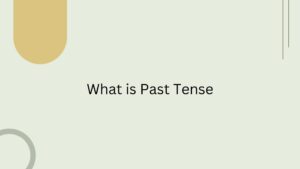The past tense is one of the most essential aspects of English grammar, used to describe actions, events, or states that occurred in the past. Whether you are recounting a personal experience, narrating a story, or discussing historical facts, the past tense enables you to situate your message in a specific time that has already passed.
The past tense is divided into four primary forms: past simple, past continuous, past perfect, and past perfect continuous. Each form serves a distinct purpose in clarifying when an event happened and whether it was completed or ongoing in the past.

1. Past Simple
The past simple tense is the most commonly used form of the past tense. It is used to describe actions or events that happened and were completed at a specific point in the past. The past simple often works with time expressions like “yesterday,” “last year,” or “two days ago.”
Formation:
For regular verbs, the past simple is formed by adding “-ed” to the base form of the verb. However, there are many irregular verbs that do not follow this pattern, such as “go” (went), “have” (had), and “take” (took).
- I visited Paris last year.
- She cooked dinner last night.
- They played football yesterday.
Uses of Past Simple:
- Completed actions in the past: “He wrote a letter yesterday.”
- A series of completed actions: “She got up, brushed her teeth, and left the house.”
- General statements about the past: “People used typewriters before computers.”
2. Past Continuous
The past continuous tense describes actions or events that were happening at a specific moment in the past or were ongoing over a period of time. It is often used when one action was in progress when another action occurred.
Formation:
The past continuous is formed using the past tense of the verb “to be” (was, were) followed by the present participle of the main verb (-ing form).
- I was reading a book when the phone rang.
- They were watching TV all evening.
Uses of Past Continuous:
- Actions in progress at a specific time in the past: “At 8 PM, I was studying.”
- Interrupted actions: “I was eating dinner when he arrived.”
- Parallel actions: “She was cooking while he was cleaning.”
3. Past Perfect
The past perfect tense is used to describe an action that was completed before another action or time in the past. It is often used to make the sequence of events clearer, especially when telling stories or recounting experiences.
Formation:
The past perfect is formed by using the past tense of “to have” (had) followed by the past participle of the main verb.
- I had finished my homework before the movie started.
- She had never seen the ocean until last summer.
Uses of Past Perfect:
- Actions completed before another past event: “By the time we arrived, the concert had started.”
- Experience or events up to a point in the past: “He had visited three countries before he turned 20.”
4. Past Perfect Continuous
The past perfect continuous tense is used to emphasize the duration of an action that was happening before another action or time in the past. It often focuses on how long the action had been ongoing before something else occurred.
Formation:
The past perfect continuous is formed by using the past tense of “to have” (had), followed by “been” and the present participle (-ing form) of the main verb.
- I had been studying for hours before I took a break.
- They had been driving for five hours when they finally reached their destination.
Uses of Past Perfect Continuous:
- Ongoing actions before another past event: “She had been working at the company for three years before she got promoted.”
- Emphasizing the duration of an action: “We had been waiting for 30 minutes when the bus arrived.”
5. Common Mistakes with the Past Tense
Learners often confuse the different forms of the past tense. Here are a few common mistakes:
- Using past simple for actions that require past perfect: For example, “I finished my homework before the movie started” should be “I had finished my homework.”
- Misusing the past continuous: Ensure the past continuous is used for actions that were in progress at a specific time or were interrupted by another action.
6. Conclusion
The past tense is vital for narrating past events, telling stories, and discussing completed actions or ongoing activities that occurred in the past. Understanding the distinctions between past simple, past continuous, past perfect, and past perfect continuous enables speakers and writers to express a wide range of ideas clearly and accurately. With practice, mastering the nuances of the past tense can make your communication more precise and effective in both written and spoken English.
